The cost of digital transformation in 2024 is projected to be significant, with global spending expected to reach nearly $3.9 trillion by 2027, growing at a compound annual growth rate (CAGR) of 16.1% from 2023.
67% of organizations are under “incredible pressure” to accelerate digital transformations. However, avoiding crucial stages like cost optimization can fail as change initiatives take far longer than expected due to incorrect costing approaches.

This article will explore digital transformation costs, covering reasons for failure, methods for reducing expenses, factors influencing costs, and best practices for cost optimization.
Why do most digital transformations fail?
There are three main reasons 70% of digital transformations fail, most related to how leaders don’t always understand the gap between technology and people and the complex nature of change.
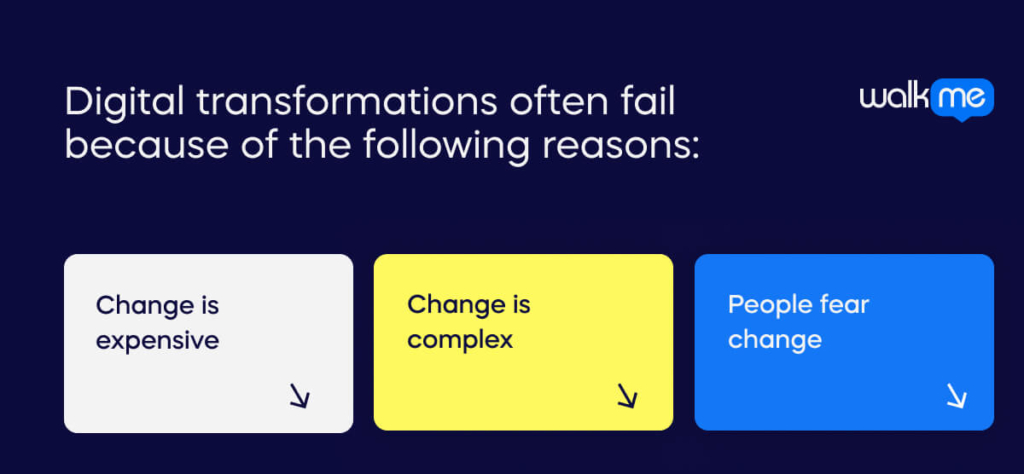
Digital transformations often fail because of the following reasons:
- Change is expensive: Change takes long periods, leading to staff stress, burnout, and even departures, delaying a transformation and increasing costs.
- Change is complex: Many organizational and individual factors contribute to the success or failure of change, making it challenging to navigate.
- People fear change: Humans value routine, so people naturally reject changes like using new digital tools.
Awareness of the reasons digital transformations fail is the key to success when calculating the cost of your digital transformation and the main reason to do it in the first place. Consider how these reasons for potential failure may impact your organization and build interventions to overcome them and guarantee transformation success.
How much does the average digital transformation cost?
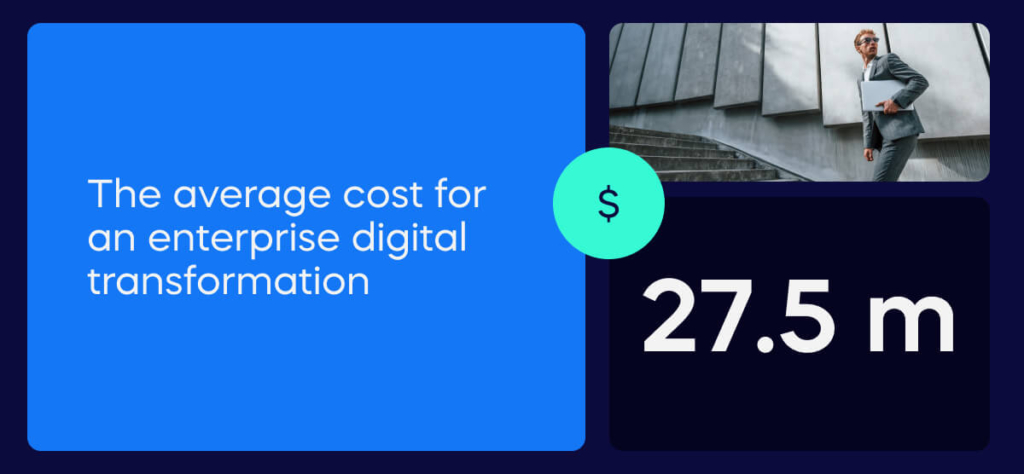
Transformations differ depending on an organization’s needs, but USD 27.5 million is the average cost for an enterprise digital transformation.
The other point is how much poor planning can cost when it results in a failed digital adoption of tools within a transformation. Poor practices such as negligence cost enterprises up to USD 100 million annually (please see citation in the introduction above).
Use this figure only as a broad guide to building your digital transformation cost budget, as many factors influence the final cost. Contingency budgets are also crucial to success, and it is essential to control waste to ensure your enterprise meets budget expectations.
10 factors that affect the digital transformation cost
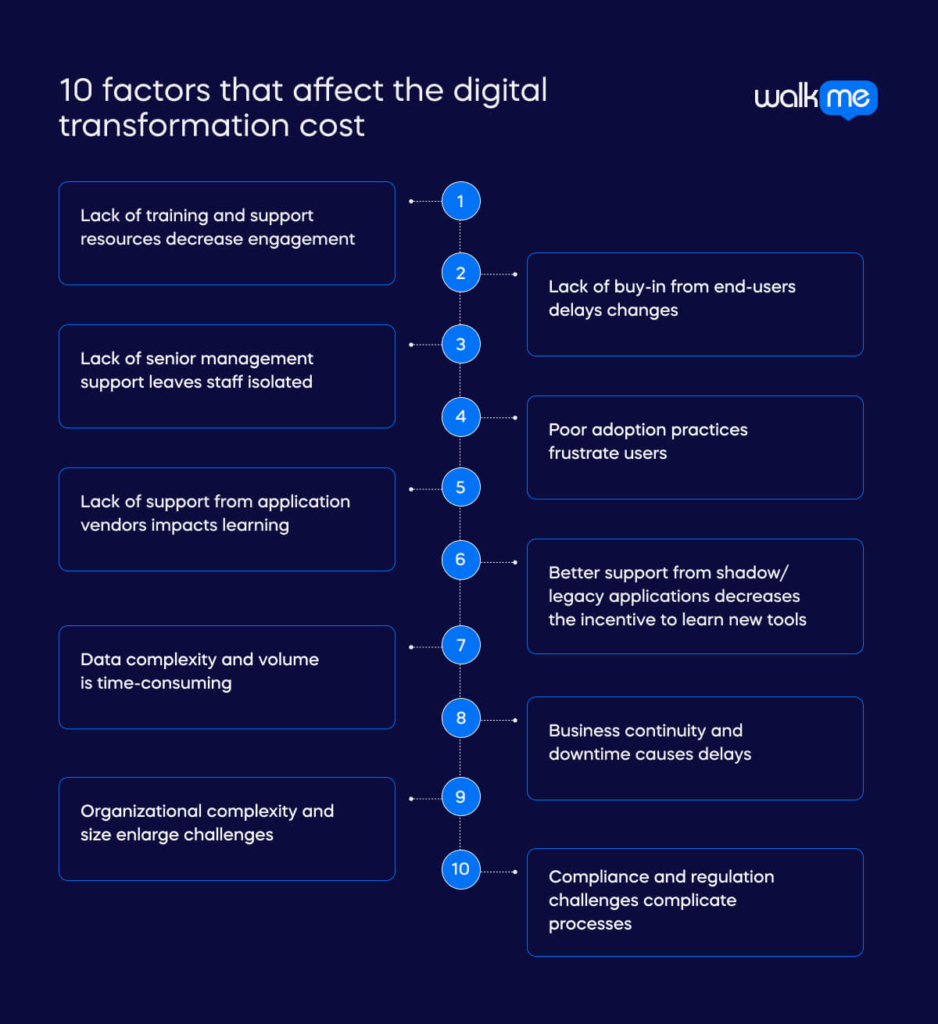
Ten main factors affect the cost of your digital transformation, including poor adoption practices, lack of buy-in from various parties, and a lack of engagement. Consider these ten factors when you plan your transformations or change initiatives to increase your chances of success.
1. Lack of training and support resources decrease engagement
A shiny new software package thrown to its users without proper training and support is like a delicate plant left parched in the desert. Engagement withers, confusion reigns, and the potential of the technology remains unrealized.
Providing comprehensive training, accessible support resources, and ongoing guidance empowers users with a digital adoption platform that helps them embrace changes, maximize the benefits, and propel the digital transformation forward.
2. Lack of buy-in from end-users delays changes
A digital makeover might shine in your head, but without the buy-in of those using it, it’s an incomplete picture.
Lack of end-user involvement breeds apathy and resistance, turning your transformation into a frustrating uphill battle. Involving users from the planning phase, addressing their concerns, and highlighting the benefits directly for them can bridge the gap and unlock the full potential of your new systems.
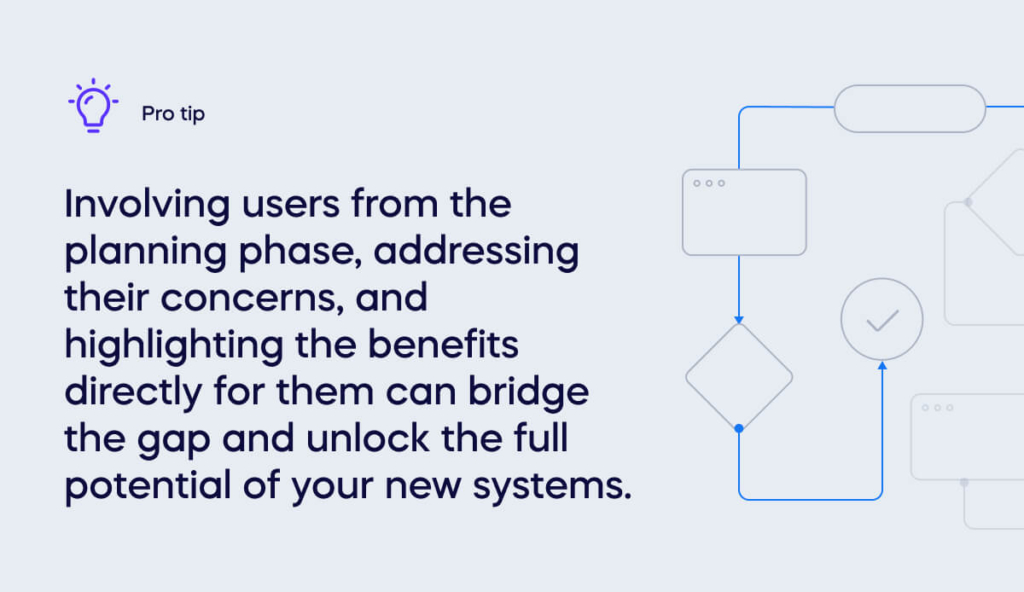
3. Lack of senior management support leaves staff isolated
Digital transformation thrives on a supportive ecosystem. The journey becomes arduous when senior management remains distant, offering lukewarm support or leaving staff to navigate the change alone.
Active leadership, clear communication, and a demonstrated commitment from higher-ups are crucial to empowering teams and ensuring a smooth, successful transition.
4. Poor adoption practices frustrate users
Imagine navigating a new digital tool with a labyrinthine interface and cryptic instructions. Frustration quickly mounts, engagement plummets, and the tool’s benefits evaporate. Poor adoption practices like these alienate users, hindering the success of your digital transformation efforts.
5. Lack of support from application vendors impacts learning
Your chosen application vendors should be active partners in your digital transformation journey, not distant figures behind a wall. Lack of responsive support, inadequate training materials, and unresponsive communication from vendors can leave you and your users floundering, hindering learning and dampening morale.
Choose vendors who actively collaborate, provide dedicated support teams, and prioritize your success as much as theirs.
6. Better support from shadow/legacy applications decreases the incentive to learn new tools
Navigating the labyrinthine regulations of heavily regulated industries is complex, but the path becomes doubly intricate for multinational companies.
Diverse national laws further layer upon established industry-specific compliance frameworks, demanding a meticulous approach to project management.
A strategic digital transformation hinges upon this meticulousness. Every technology decision must be through the lens of regulations, from GDPR compliance to the nuanced demands of each relevant industry. While expert guidance in navigating this compliance landscape adds to the cost, the price of non-compliance is far steeper.
7. Data complexity and volume is time-consuming
Data, the lifeblood of modern business, can become trapped and unseen by most of the organization in the silos of legacy systems. These systems are designed for a bygone era and struggle to support today’s data-driven demands. Integrating data from various sources becomes a laborious, if not impossible, task, hindering crucial analytics and insights.
A comprehensive vision for the future drives the decision to modernize. By embracing the transformative power of modern data ecosystems, businesses pave the way for sustained growth and profitability.
8. Business continuity and downtime causes delays
Band-aiding legacy systems get workflows going but create long-term technical debt. Upgrading means facing that debt head-on. Analyze it, then choose your tool to journey to success.
API Integration
Facilitate seamless interoperability between legacy software and modern systems by implementing an application programming interface (API) layer.
Platform Modernization
Undertake a strategic shift towards a more contemporary platform or perform targeted code refactoring within the existing platform to improve performance and maintainability.
Cloud-Native Development
Embrace the agility and scalability of cloud-based solutions by building new applications specifically designed for the cloud environment.
Sure, comprehensive approaches cost more now, but they slash future debt and future-proof your business.
9. Organizational complexity and size enlarge challenges
Large organizations face a unique Everest when it comes to digital transformation. Their vast data ecosystems, sprawling user bases, and complex app landscapes demand a different climb. Unlike their mid-size and startup counterparts, their IT and transformation costs, like operational expenses, naturally reach higher altitudes.
But size alone isn’t the sole sherpa of price tags. The intricate dance of size and complexity sets the rhythm of transformation costs. Think of it like Euro Car Parts, the UK and Europe’s leading car parts supplier. Over 150,000 auto parts move through their digital ecosystem, making their recent eCommerce UI/UX revamp a monumental undertaking.
10. Compliance and regulation challenges complicate processes
A comprehensive cost analysis of digital transformation goes beyond the mere sum of technology and labor. To paint a complete picture, it’s crucial to factor in the potential downtime costs and compromised customer experience during the transition.
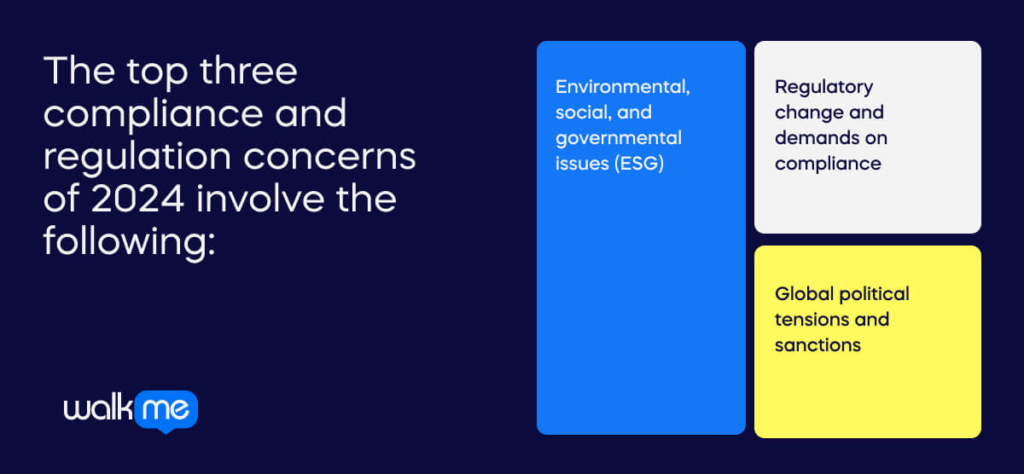
The top three compliance and regulation concerns of 2024 involve the following:
- Environmental, social, and governmental issues (ESG) involving federal and state jurisdictions in the US, covering issues like tax fairness and executive pay.
- Regulatory change and demands on compliance are responsibilities of the U.S. Securities and Exchange Commission (SEC) and include issues such as tariffs and trade policies.
- Global political tensions and sanctions, with examples in 2023 being the Russian-Ukraine conflict impacting Russian business partnerships.
While such extreme disruptions are challenging to predict, the risk of service interruptions warrants advance consideration and preparation in any transformation decision. This factor underscores the importance of choosing an experienced digital transformation partner who prioritizes customer satisfaction and seamless experience.
This approach is needed to avoid damage to the brand image by not following policies and attracting negative media attention, which can delay a digital transformation as the focus shifts to protecting the company’s public perception.
Best practices to lower digital transformation cost
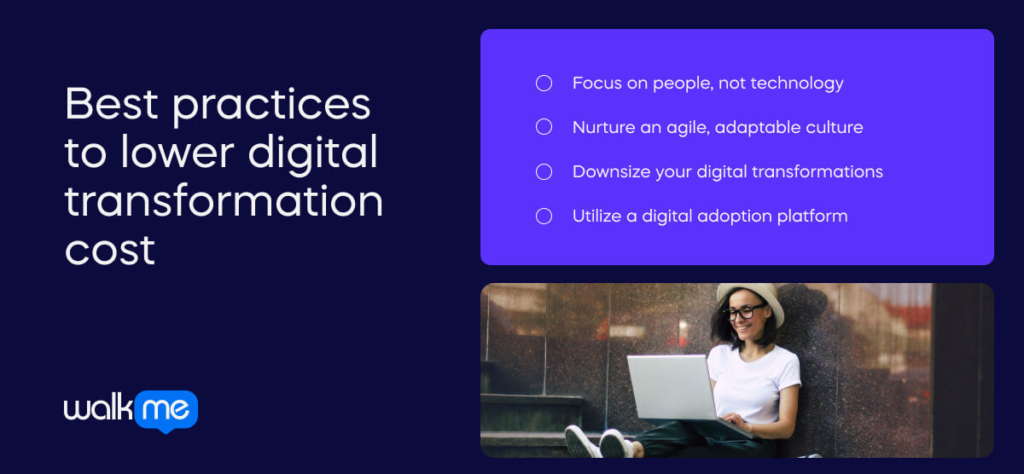
Follow these best practices to ensure success when reducing your digital transformation cost without negatively impacting the quality or long-term nature of changes or your staff.
Focus on people, not technology
Focusing solely on technological instruments in the digital transformation symphony risks discordant, costly results. The secret melody lies in prioritizing the human chorus: your employees.
Engaging them early, understanding their needs, and equipping them with proper training ensures they don’t become reluctant backup singers. This “people-first” approach minimizes costly resistance, maximizes adoption, and unlocks the true potential of your digital investments, turning transformation from a budget strain into a harmonious chorus of productivity and return.
Nurture an agile, adaptable culture
In the dance of digital transformation, rigid structures lead to costly missteps. Cultivate an agile, adaptable culture instead. Empower teams to experiment, iterate rapidly, and embrace change.
This skill allows course correction without heavy budgetary backtracks. Small, agile wins build momentum and confidence, fostering innovation without overextending the budget. Embrace adaptability, and your transformation budget waltzes to the rhythm of continuous improvement, not costly stagnation.
Downsize your digital transformations
The allure of sweeping digital transformation initiatives can be intoxicating, but overreach often leads to budgetary heartburn. A more prudent approach? Take controlled sips with deconstructed transformations.
Begin with discrete projects focused on critical pain points, savoring timely victories to build momentum and whet the appetite for more significant steps. This iterative strategy avoids the indigestion of wasted investments arising from excessive ambition.
Embrace a tapas mentality, relishing manageable changes like bite-sized delicacies, ensuring a resource-conscious digital evolution.
Utilize a digital adoption platform
A digital adoption platform (DAP) has many benefits in reducing digital transformation costs and ensuring the success of any change initiative.
Utilize a DAP to reap the following benefits:
- Reduce 1:1 personal training time, as staff can train independently as they work using in-app guidance to learn new features as they complete daily tasks, keeping training costs of your transformation low.
- Reducing frustration and improving employee retention is essential to a successful digital transformation as you retain the knowledge and experience of new tools, avoiding recruitment costs.
- Track user behavior and engagement, providing valuable data to identify areas for improvement, adjust training, and optimize the user experience as you transition to new technologies.
- Accelerate the adoption of new features and updates, allowing organizations to innovate faster and stay ahead of the curve as staff become used to and enjoy large-scale change.
Boost engagement to reduce transformation costs
The key to successful digital transformation costing is prioritizing your staff over the new technology you’re asking them to use. Achieve this by boosting engagement to squeeze the value out of every penny.
Prioritizing user engagement isn’t simply a feel-good practice; it’s a strategically sound investment in a successful and cost-effective digital transformation. By nurturing enthusiastic adoption, you reduce costly resistance, minimize retraining needs, and unlock the full potential of new systems.
The empowered workforce becomes both the engine of transformation and the beneficiary of its rewards, creating a virtuous cycle of productivity and financial sustainability. Never underestimate the power of engaged employees – they are the hidden ROI champions of successful digital transformation cost practices.


